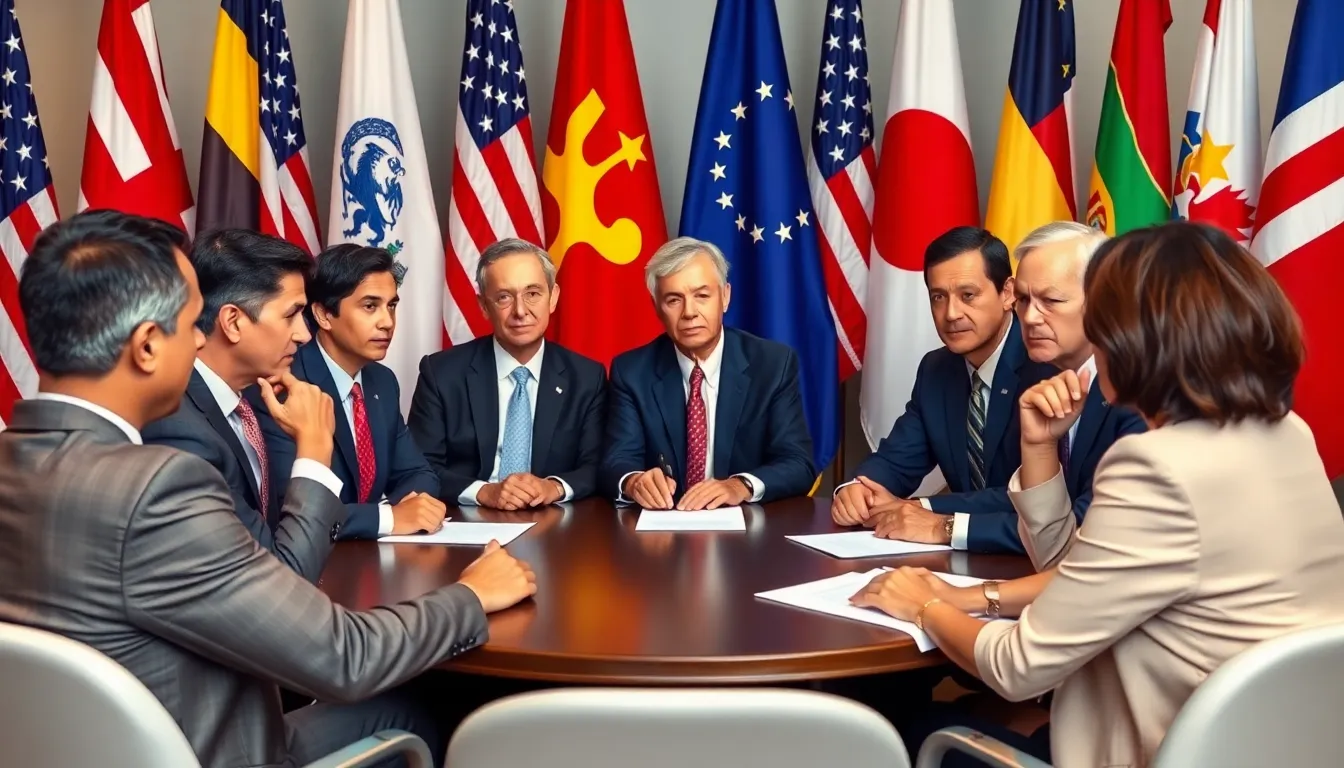In the ever-evolving world of international relations, understanding the underlying theories can feel like trying to solve a Rubik’s Cube blindfolded. Enter constructivism—a theory that flips the script on traditional views. Instead of focusing solely on power dynamics or economic interests, constructivism dives into the realm of ideas, identities, and social constructs. It’s like realizing that behind every diplomatic handshake or heated debate, there’s a complex web of beliefs and norms shaping those interactions.
Imagine a world where nations are not just players on a chessboard but storytellers weaving narratives that influence their actions. Constructivism invites us to consider how perceptions and shared values impact global affairs. So buckle up, because exploring this theory might just change the way one thinks about international relations forever. Who knew that understanding the world could be so much fun?
Table of Contents
ToggleOverview of Constructivism
Constructivism represents a critical shift in international relations, emphasizing the role of ideas, identities, and social constructs. This theory challenges conventional perspectives that prioritize material power and economics.
Historical Context
Constructivism emerged in the late 20th century as a response to dominant theories like realism and liberalism. The end of the Cold War created an environment for new perspectives in global politics. Scholars began to question the rigidity of existing paradigms, focusing on how social factors influence state behavior. Key events, such as the rise of global civil society and transnational networks, further highlighted the importance of shared norms and identities. These developments illustrated that relationships among states are not solely defined by power dynamics, but also by the perceptions and beliefs that shape interactions.
Key Theorists
Several theorists significantly contributed to the development of constructivism. Alexander Wendt is a notable figure, famous for his work “Social Theory of International Politics.” His arguments highlighted how anarchy in international relations is not inherent but constructed through social interactions. Martha Finnemore further enriched constructivism, emphasizing the role of norms and international organizations in shaping state behavior. Additionally, Peter Katzenstein showcased how domestic factors influence national identity and foreign policy. These theorists collectively established constructivism as a significant framework for understanding international relations, emphasizing the impact of social constructs on global affairs.
Core Principles of Constructivism

Constructivism in international relations relies on several core principles that shape its framework. These principles highlight the importance of social context and shared understandings.
Social Constructs
Social constructs refer to the ideas and beliefs that define state interactions. Norms and values influence how states perceive each other, affecting diplomatic discussions. Constructivists assert that these constructs are not static; they evolve over time through social interactions. States engage in ongoing dialogues that impact their identities and policies, demonstrating the fluid nature of international relations. By focusing on shared understandings, constructivism underscores how collective meanings shape conflict resolution and cooperation.
Role of Identity
Identity plays a crucial role in constructivism, influencing how states see themselves and others. States create identities based on historical experiences, culture, and political values. These identities inform foreign policy choices and alignments with other states. Understanding one’s identity aids states in interpreting actions and motivations of international counterparts. Varied identities can result in different interpretations of events, leading to unique responses in diplomacy. Consequently, the lens of identity allows for a deeper comprehension of the complexities in state behavior and international interactions.
Constructivism vs. Other Theories
Constructivism offers a distinct perspective compared to traditional international relations theories like realism and liberalism. This theory emphasizes social constructs and their influence on state behavior.
Realism
Realism focuses on power, assuming states operate in a self-interested manner. National security drives state actions within an anarchic international system. Power dynamics dictate interactions, and states prioritize military capabilities. Constructivism, however, argues that social interactions and shared norms shape state identity and behavior. The interaction of states includes narratives and values that realism overlooks. In contrast to realism, constructivism highlights the importance of social understanding, suggesting that states build relationships based on shared beliefs and identities.
Liberalism
Liberalism prioritizes cooperation and interdependence among states, advocating for institutions and economic ties as drivers of peace. States seek mutual benefits through trade and international organizations. Unlike realism, liberalism acknowledges the significance of cooperation. Constructivism aligns with liberalism by recognizing the role of international norms and values in influencing state behavior. Social constructs shape relationships and diplomatic efforts, making collaboration possible. Moreover, constructivism adds depth to liberalism’s arguments by emphasizing how identities and perceptions influence state cooperation.
Applications of Constructivism in International Relations
Constructivism finds practical application in various aspects of international relations, providing fresh insights through case studies and practical implications.
Case Studies
Various case studies exemplify constructivism’s relevance. The post-Cold War era illustrates how shared identities reshaped European security arrangements. The European Union emerged as a response to historical antagonisms and common aspirations for peace. Additionally, the U.S. engagement with China highlights how social factors influence diplomatic and economic interactions. The evolving perception of China from a rival to a strategic partner demonstrates the power of narratives in international relations. Such examples emphasize that states’ behaviors are often dictated by underlying identities and shared beliefs.
Practical Implications
Practical implications of constructivism surface in global policymaking. Understanding the role of social constructs encourages states to engage in dialogue rather than confrontation. Negotiations around climate change agreements illustrate how identities shape collaborations, pushing nations toward collective action. Organizations, such as the United Nations, utilize shared norms to foster international cooperation. Emphasizing social factors can lead to more sustainable foreign policies, empowering states to redefine interests based on shared values. Integrating constructivism into policymaking promotes a deeper understanding of global challenges, fostering a more cooperative international environment.
Critiques of Constructivism
Constructivism, while offering valuable insights, faces several critiques.
Limitations
Critics highlight the theory’s focus on social constructs, arguing it downplays material factors like military power. Constructivism’s tendency to emphasize shared identities may overlook the significance of economic interests in state behavior. Additionally, it struggles to provide testable predictions, often leading to vague conclusions. The theory lacks a clear systematic approach, making it challenging for policymakers to apply in practical scenarios. Constructivism’s emphasis on norms might also ignore how states frequently act against established norms for strategic gains.
Alternative Perspectives
Realism remains a prominent alternative, focusing on power dynamics and national interests in an anarchic system. According to realists, states prioritize security and survival, often disregarding social factors. Liberalism presents another viewpoint, emphasizing the role of institutions and cooperation while acknowledging interdependence. Unlike constructivism, these perspectives provide clear frameworks for understanding state actions. Additionally, critical theories such as post-structuralism challenge constructivist notions by questioning underlying assumptions about identity and power relations. These alternative perspectives offer distinct lenses for analyzing international relations, emphasizing different elements at play in global politics.
Constructivism in international relations offers a transformative perspective that goes beyond traditional theories. By focusing on the significance of social constructs and identities, it provides a nuanced understanding of how states interact on the global stage. This approach emphasizes the power of narratives in shaping diplomatic relations and encourages cooperative engagement among nations. While it faces critiques regarding its practical application and predictive capabilities, constructivism remains a vital framework for analyzing contemporary global issues. Its insights into the interplay of ideas and identities continue to influence both academic discourse and policymaking, highlighting the importance of understanding the social dimensions of international relations.


